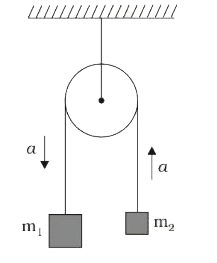A moving body with a mass m1 strikes a stationary body of mass m2. The masses m1 and m2 should be in the ratio m1m2 so as to decrease the velocity of the first body 1.5 times assuming a perfectly elastic impact. Then the ratio m1m2 is
5
1/5
1/25
25
The correct Answer is:A
m1u=m12u3+m2u (By condition o linear momentum)
⇒13m1u=m2v………..(i)
Also e |(v1−v2)||(u2−u1)|
⇒v−2u3=u⇒v=53u…..(ii)
From (i) and (ii), 13m1u=53m2u⇒m1m2=5
Topper's Solved these Questions
- CONCEPT BUILDERBook:DISHA PUBLICATIONChapter:CONCEPT BUILDERExercise:Exercise-1 Concept Builder (topic 4:Collisions)
Explore 1 Video
- COMMUNICATION SYSTEM Book:DISHA PUBLICATIONChapter:COMMUNICATION SYSTEM Exercise:EXERCISE-2 : Concept Applicator
Explore 30 Videos
- CURRENT ELECTRICITYBook:DISHA PUBLICATIONChapter:CURRENT ELECTRICITYExercise:EXERCISE-2 Concept Applicator
Explore 23 Videos
Similar Questions
Two bodies of masses m1andm2(<m1) are connected to the ends of a massless cord and allowed to move as shown in figure. The pulley is both massless and frictionless. The acceleration of the centre of mass is (m1−m2)n(m1+m2)2g. Find the value of n.

View SolutionTwo bodies of masses m1 and m2 have equal KE. Their momenta is in the ratio
View Solution
Knowledge Check
Two bodies of masses m1 and m2 have equal KE. Their momenta is in the ratio
A√m2:√m1Bm1:m2C√m1:√m2Dm21:m22If two masses m1 and m2 collide, the ratio of change in their respective velocities is proportional to
Am1m2B√m1m2Cm2m1D√m2m1A body of mass m1 is moving with a velocity V. it collides with another stationary body of mass m2. They get embedded. At the point of collision, the velocity of the system.
AIncreasesBDecreases but does not become zeroCRemains sameDBecome zero
A body of mass m1 is moving with a velocity V. it collides with another stationary body of mass m2. They get embedded. At the point of collision, the velocity of the system.
View SolutionA body A mass m1 exerts a force on another body B of mass m2 . If the acceleration of B be a2 , then the acceleration (in magnitude) of A is
View SolutionA body of mass m moving with a velocity v strikes a statioinalry body of mass m and sticks to it. What is the speed of the system?
View SolutionA body of mass m1 collides elastically with another body of mass m2 at rest. If the velocity of m1 after collision is 23 times its initial velocity, the ratio of their masses is :
View SolutionA body of mass m1 moving with a velocity 3m/s collides with another body at rest of m2 . After collision the velocities of the two bodies are 2m/s and 5m/s , respectively , along the direction of motion of m1. The ratio m1/m2 is
View Solution